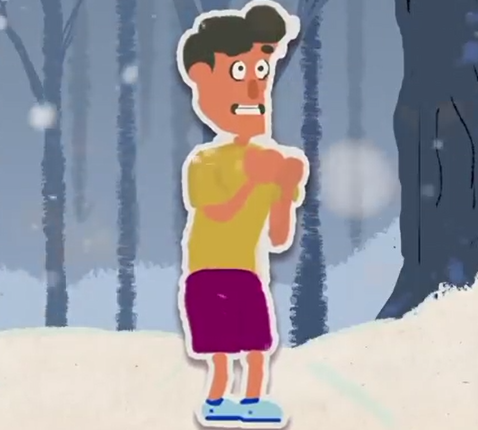It's almost winter where Squeaks and I live, which means it's starting to get much colder outside!
我和吱吱住的地方快到冬天了,也就是说外面变得更冷了。
And that means it's time to get out our jackets and mittens and hats.
这意味着是时候拿出我们的夹克、手套和帽子了。
Sometimes, when I get too cold, like if I forget my hat one day, I start to shiver.
有时,我很冷时,比如我某天忘了戴帽子,就会打颤。
Maybe that's happened to you, too:
或许你也这样过:
when we shiver, we shake back and forth, and can't stop even if we try!
我们打颤时会来回摇晃,而且停不下来。
Shivering might not be very fun, but it's an important way for our bodies to keep us warm.
打颤可能无趣,但这是身体保暖的重要方式。
See, no matter how cold or hot it is outside,
看,不管外面多冷或多热,
the insides of our bodies have to stay at about the same temperature all the time.
我们体内的温度一直保持不变。
That keeps our bodies comfortable and working properly.
这让我们的身体保持舒适和正常工作。
So our bodies have built-in ways to keep our temperature pretty much the same no matter what it's like outside.
所以不管外面是什么样子,我们的身体有内在方法来保持温度不变。
For example, if you get too hot, like if you're running around, you're probably going to sweat.
举个例子,如果你太热,比如你到处跑,可能会出汗。
And that sweat helps to cool your body down.
汗液会帮助你的身体降温。
Well, shivering does the opposite of sweating:
打颤与出汗的作用相反:
it helps to make our bodies warmer when we get too cold.
当我们太冷时,它能让我们变暖。
Heat is leaving your body all of the time, even though you don't usually notice it.
热量一直从你的体内流失,即使你没注意到。
Do you know how when you have a hot bowl of soup, sometimes you can see the steam rising from it.
你有一碗热汤时,你有时能看到上面的蒸汽。
That steam is some of the heat leaving the soup as it cools off.
蒸汽是离开汤的某些热量冷却形成的。
And the same kind of thing happens with our bodies.
我们的身体也发生了类似的事。
We don't give off steam, but there's still heat leaving our bodies!
我们不释放蒸汽,但仍有热量离开身体!
When you wear a jacket or sweatshirt, the heat gets trapped between your body and the clothing.
当你穿夹克或运动衫时,热量就会困在身体和衣服之间。
This trapped heat helps keep your body from getting too cold.
这些被困的能量有助于身体保温。
If it's really cold outside and you're not wearing a jacket,
如果外面真得太冷,而你又没穿夹克,
then there's nothing to keep the heat from escaping into the air around you.
就没有东西能阻止你体内的热量逸到空气中了。
After a while, the temperature inside of your body will start to go down a little.
不久,你体内的温度就会开始一点点儿下降。
When it gets down far enough, you start to shiver.
当下降得太多时,你就会开始打颤。

Shivering starts in a special part of your brain that controls your body temperature.
打颤是从控制体温的某个特殊大脑部位开始的。
Once this part of your brain gets the message from your body that you're starting to feel pretty chilly,
一旦这个大脑部位从你的身体得到感觉太冷的信息,
it sends out a message of its own to different parts of your body to fix the problem.
就会向身体的不同部位发消息解决这个问题。
And it sends this message without us having to do a thing.
它发送这个消息时,我们什么都不用做。
Shivering is a good example of a reflex, something our bodies do without us having to think about them.
打颤是反射的好例子,有时我们的身体不经思考就会行动。
If someone tosses you something,
如果有人向你扔东西,
and it's a little too high, and headed right toward your face....look out, Squeaks!
它抛得有点儿高,正对着你的脸来...吱吱,小心!
You're probably going to duck, and you probably close your eyes, too, without even thinking about it!
你可能会躲起来,也可能会不加思索地就闭眼!
Ducking and blinking are reflexes, and in this case, they help to protect your head and eyes from getting hurt.
躲避和眨眼都是反射,这样,就能保护头和眼睛免受伤害。
With the shivering reflex, your brain keeps your body from getting too cold by telling your muscles to move.
由于打颤反射,你的大脑告诉肌肉运动,防止你变冷。
You probably already know that your muscles help your body move around.
你可能知道肌肉能帮助身体运动。
And moving muscles give off heat.
肌肉运动会释放热量。
That's one reason you get hot when you exercise.
这就是你运动时会变热的原因。
When we shiver, our muscles move in a different way than when we walk or lift something.
当我们打颤时,肌肉会以不同于走路或提东西的方式运动。
They get tight and then loose really quickly, over and over again, they keep squeezing and relaxing.
它们反复快速地收缩舒张,不断挤压和放松。
When our muscles move this way, they can make our bodies shake back and forth.
当我们的肌肉这样运动时,身体就会来回摇晃。
That's shivering!
这就是打颤!
Meanwhile, we usually also do other things to get warm, like put on more clothing, or wrap up in a blanket.
与此同时,我们也有其他的保暖方法,比如穿更多的衣服或裹个毯子。
Once our bodies get warm enough again,
一旦我们的身体再次变暖,
that special part of the brain sends a signal to the muscles to stop moving, and we stop shivering.
大脑的特殊部位就会给肌肉发信号让它停止运动,我们就会停止打颤。
Of course, the best way to keep from shivering in the first place is to wear warm clothes.
当然,我们停止打颤的首要方法是穿暖和的衣服。
Wearing more than one layer is a good way to keep especially warm,
多穿几层是保暖的好方法,
because each layer can trap more heat.
因为每一层都能困住更多的热量。
We can also wear mittens and hats to keep the heat from escaping from our heads and hands.
我们也可以戴手套和帽子来防止热量从头部和手上散失。
All this talking about keeping warm reminds me:
这些保暖的方法提醒我
we need to dig our warm jackets out of the closet!
我们要把暖夹克从橱柜拿出来穿上了!
Before we go, thanks for joining us on SciShow Kids!
在我们走之前,要感谢您收看本期的儿童科学秀!
And if you have a question about something, we'd love to hear from you!
如果你对什么问题有疑问,可以写信给我们!
Ask a grownup to help you to leave a comment down below or send us an email at kids@scishow.com!
找个大人帮忙在下方留言或发邮件至kids@scishow.com!
Thanks! We'll see you next time, here at the Fort!
感谢您收看!我们下期见,沃斯堡等你哦!


